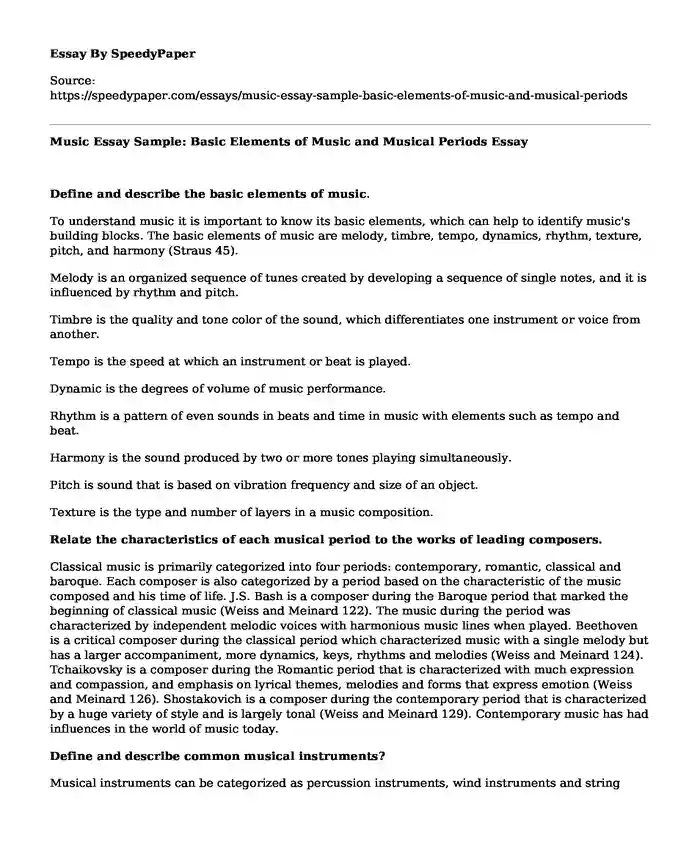Define and describe the basic elements of music.
To understand music it is important to know its basic elements, which can help to identify music's building blocks. The basic elements of music are melody, timbre, tempo, dynamics, rhythm, texture, pitch, and harmony (Straus 45).
Melody is an organized sequence of tunes created by developing a sequence of single notes, and it is influenced by rhythm and pitch.
Timbre is the quality and tone color of the sound, which differentiates one instrument or voice from another.
Tempo is the speed at which an instrument or beat is played.
Dynamic is the degrees of volume of music performance.
Rhythm is a pattern of even sounds in beats and time in music with elements such as tempo and beat.
Harmony is the sound produced by two or more tones playing simultaneously.
Pitch is sound that is based on vibration frequency and size of an object.
Texture is the type and number of layers in a music composition.
Relate the characteristics of each musical period to the works of leading composers.
Classical music is primarily categorized into four periods: contemporary, romantic, classical and baroque. Each composer is also categorized by a period based on the characteristic of the music composed and his time of life. J.S. Bash is a composer during the Baroque period that marked the beginning of classical music (Weiss and Meinard 122). The music during the period was characterized by independent melodic voices with harmonious music lines when played. Beethoven is a critical composer during the classical period which characterized music with a single melody but has a larger accompaniment, more dynamics, keys, rhythms and melodies (Weiss and Meinard 124). Tchaikovsky is a composer during the Romantic period that is characterized with much expression and compassion, and emphasis on lyrical themes, melodies and forms that express emotion (Weiss and Meinard 126). Shostakovich is a composer during the contemporary period that is characterized by a huge variety of style and is largely tonal (Weiss and Meinard 129). Contemporary music has had influences in the world of music today.
Define and describe common musical instruments?
Musical instruments can be categorized as percussion instruments, wind instruments and string instruments (Straus 24). String instruments produces sound when the string vibrates through hitting, strumming and plucking. Examples of string instruments are harp, guitar and violin. Wind instruments produce sound when air is blown in them, for example saxophone, flute, trumpet and clarinet. Percussion instruments produce sound when they are hit or struck, for example xylophone, bells, drums and the triangle.
Define and describe the major periods of music history.
Classical music is primarily categorized into four periods: contemporary, romantic, classical and baroque (Weiss and Meinard 120).
Baroque Period: Baroque period took place between 1600 and 1750 (Weiss and Meinard 122). It marked the beginning of classical music with two or more independent melodic voices that is harmonious when played together.
Classical Period: Classical period took place between 1750 and 1830 (Weiss and Meinard 124). It evolved from Baroque for of music, and it emphasized on a single melody with accompaniment leading to music with a well defined melody, dynamics and rhythms.
Romantic Period: Romantic period occurred between 1830 and 1920 (Weiss and Meinard 126). It was characterized by much expression and passion compared to the earlier periods. The lyrical melodies and themes had more personal expression of emotion.
Contemporary Period: The period happened between 1920 to present. It is characterized by a huge variety of style and is largely tonal (Weiss and Meinard 129). Contemporary music has had influences in the world of music today.
Define and compare major genres within each period. Identify selected compositions, their composers, and historical periods.
Baroque Period
The idea of orchestra was born during the Baroque period. This genre was rather soft grained viol string family. The view that instruments needed to be played together led to the development of modern orchestra (Weiss and Meinard 122). Composers in orchestra genre were able to illustrate mood in their music and influence the emotion of the listener.
Classical Period
The major genres during this period were symphony, comic operas and sonata, which were distinct from folk, jazz and pop music. Orchestras evolved to include a cello, a viola and two violins, which followed a format suggestive of the symphony (Weiss and Meinard 124). A piano was also used during this period to create solo pieces especially sonata.
Romantic Period
Most genres in this period were more inventive and expensive. Primarily passionate songs, dramatic operas, virtuosic piano music and expansive symphonies took the form of literature and art (Weiss and Meinard 126). These genres would be performed with ease for the enjoyment of the audience using story lines such as tragedy attached to it.
Contemporary Period
Genres in this period were so diverse with styles adopted from major periods of classical music. Composers pulled from opposite directions as some like Lehar still used Opera style that had been used may centuries ago (Weiss and Meinard 129).
Works Cited
Straus, Joseph Nathan. Elements of Music. Pearson College Division, 2008.
Weiss, Christof, and Meinard Muller. "Tonal Complexity Features For Style Classification Of Classical Music." ICASSP. 2015.
Cite this page
Music Essay Sample: Basic Elements of Music and Musical Periods. (2022, Jul 19). Retrieved from https://speedypaper.net/essays/music-essay-sample-basic-elements-of-music-and-musical-periods
Request Removal
If you are the original author of this essay and no longer wish to have it published on the SpeedyPaper website, please click below to request its removal:
- Free Essay: Getting out of Debt is Like Holding a Tea Party in Difficult Situation
- Story About My Life - Personal Essay Example
- Employee Privacy Rights and Packet Sniffers. Free Essay Sample.
- Essay Example Dedicated to Dr. John Cade and His Discovery
- Paper Example on Eco-Friendly (Green) Choices
- Essay Sample on Job Satisfaction Annotated Bibliography
- Free Essay: Truancy, Grade Point Average and Sexual Activity
Popular categories





